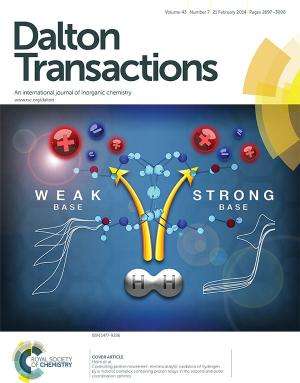If water is used as a base to remove the protons, compared to a strong amine base, the proton's behavior and the catalyst's response changes according to scientists at the Center for Molecular Electrocatalysis. Artwork by Dr. Jonathan Darmon, PNNL. Credit: Royal Society of Chemistry.
Do protons speed through a catalyst, take the scenic route, or stop altogether? Using their understanding of a proton's choices, scientists at the Center for Molecular Electrocatalysis revised their nickel-based catalyst to quickly handle one of a fuel cell's tough challenges: breaking chemical bonds and freeing the stored electrons to work. The catalyst's speed comes from an additional, second proton relay, a molecular fragment, on the outer edge. With the second proton relay, the catalyst quickly transforms through three different isomers, or forms, and the proton goes on its way. Without the relay, the catalyst sticks in one form and moving the proton from the active site takes much longer. Also, the team discovered that the proton's behavior and the catalyst's response changes if water is used as a base to remove the protons, compared to a strong amine base. The catalyst's response to the different bases graces the cover of Dalton Transactions.
"We need to control proton movement over greater distances to generate catalysts that operate efficiently and quickly," said Dr. Monte Helm, who worked on the study and serves as the Center for Molecular Electrocatalysis' Deputy Director. "This study is just one example of our progress."
The Center for Molecular Electrocatalysis is an Energy Frontier Research Center led by Pacific Northwest National Laboratory and funded by the U.S. Department of Energy's Office of Basic Energy Sciences.
Fuel cells could store massive quantities of intermittent solar- or wind-generated energy and release it when needed. The cells can store energy or electrons in a bond between two hydrogen atoms. When needed, the fuel cell breaks the hydrogen-hydrogen bond, freeing the electrons to do work. However, fuel cells do not play a major role in our nation's energy economy because they require platinum catalysts, which are too expensive to be used on a large scale.
"Changing our nation's energy landscape requires us to devise efficient catalysts from cheap, abundant metals," said Dr. R. Morris Bullock, who worked on the study and directs the Center for Molecular Electrocatalysis.
The research team began by adding a methoxy group (-CH2CH2OMe) to the pendant amine to serve as a second proton relay in the outer coordination sphere of a nickel bis(diphosphine) catalyst. The methoxy group was added to move protons away from the active site quickly so that the next reaction could begin. They synthesized the compounds they needed and characterized them with nuclear magnetic resonance (NMR) spectroscopy, x-ray crystallography, and a variety of other spectroscopic techniques. Once characterized, the compound's catalytic H2 oxidation properties were studied by electrochemistry.
They found that in moving protons, this nickel catalyst does not behave the way others in its class do. To move the protons, the catalyst twists and turns. The added methoxy group weakened key bonds between nickel and hydrogen atoms, allowing the catalyst to isomerize quickly.
"What we'd seen previously was that the transfer can take days; what we found is that the catalyst can do this isomerization very quickly-faster than any other catalysts we've tested so far," said Dr. Molly O'Hagan, a chemist at PNNL who worked on the study.
When the catalyst was placed under 1 atmosphere of H2 pressure, it broke 5 hydrogen bonds every second (overpotential of 720 mV) when water was used as a base to remove the protons. When a strong base was used to remove the protons, the rate went up to 18 molecules per second, with a lower overpotential. The team discovered the faster reaction did not follow the same twists and turns as the slower reaction in water.
"This research demonstrates our ability to control both the speed and required energy of the catalyst by modifying the outer layers of the catalyst, an area once thought to be unimportant for synthetic catalysts" said Helm.
What's Next?
"Scientists at the Center have learned how to move protons to and from the metal center over short distances using proton relays in the secondary coordination sphere. We've realized now that we need to control proton movement at greater distances," said Helm. The team is working to move the protons greater distances and to answer other fundamental questions involved in efficiently moving protons to create catalysts with platinum's speed and efficiency, but not its cost.
More information: Das P, MH Ho, MJ O'Hagan, WJ Shaw, RM Bullock, S Raugei, and ML Helm. 2014. "Controlling Proton Movement: Electrocatalytic Oxidation of Hydrogen by a Nickel(II) Complex Containing Proton Relays in the Second and Outer Coordination Spheres." Dalton Transactions 43:2744-2754. DOI: 10.1039/C3DT53074D
Journal information: Dalton Transactions
Provided by Pacific Northwest National Laboratory






















